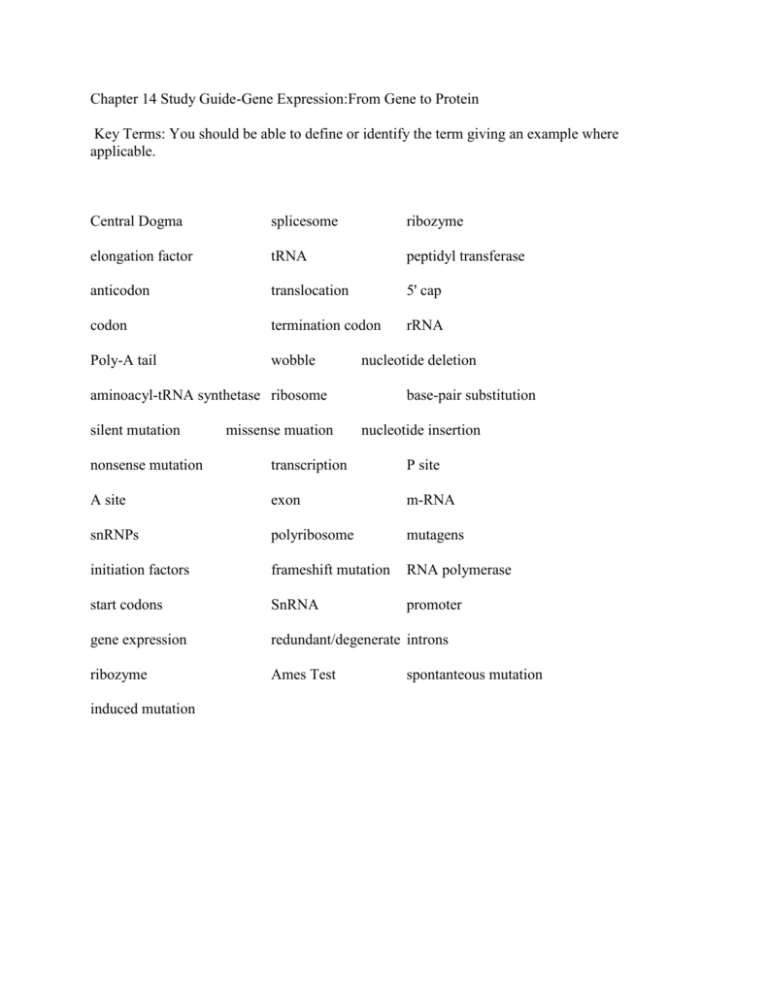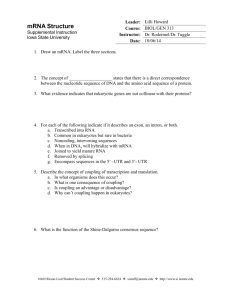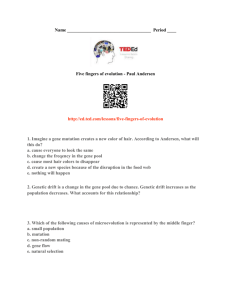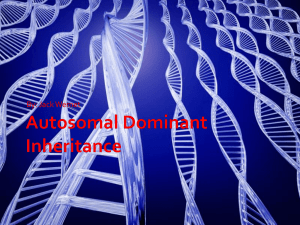From Gene to Protein Chapter 14
advertisement

Chapter 14 Study Guide-Gene Expression:From Gene to Protein Key Terms: You should be able to define or identify the term giving an example where applicable. Central Dogma splicesome ribozyme elongation factor tRNA peptidyl transferase anticodon translocation 5' cap codon termination codon rRNA Poly-A tail wobble nucleotide deletion aminoacyl-tRNA synthetase ribosome silent mutation missense muation base-pair substitution nucleotide insertion nonsense mutation transcription P site A site exon m-RNA snRNPs polyribosome mutagens initiation factors frameshift mutation RNA polymerase start codons SnRNA promoter gene expression redundant/degenerate introns ribozyme Ames Test induced mutation spontanteous mutation Review Questions: 1. How is DNA different from RNA? What is the relationship between the sequence of nucleotides in a gene and the sequence of amino acids in the polypeptide that this gene codes for? 2. What is the Central Dogma? Use the Central Dogma to explain how genotype determines phenotype. 3. What are the advantages to the cell of making an RNA copy of DNA to participate in protein synthesis rather than using the DNA molecule itself. 4. Define codon, and explain what relationship exists between the linear sequence of codons on m-rna and the linear sequence of amino acids in a polypeptide. 5. Even before the triplet nature of the genetic code was verified, a triplet code made logical sense to many investigators. Referring to the number of common amino acids that exist, explain their logic. 6. Describe the following features of the genetic code. It is redundant, it is universal, and it is nonoverlapping. Explain any exceptions to these "rules". 7. Using the following terms (RNA polymerase II, promoter, transcription factors, TATA box, termination sequence) describe the three key steps of transcription (polymerase binding and initiation, elongation, and termination). 8. What does it mean when we say that a gene has been expressed? How does this relate to the concepts of transcription and translation? 9. Referring to the following terms (m-rna binding site, large subunit, small subunit, P site, A site, and E sites) discuss how the structure of a ribosome relates to its function. 10. What is S value ? What does it tell you about a particle? In terms of S value, how do prokaryotic ribosomes differ from eukaryotic ribosomes? What do these differences have to do with the therapeutic use of antibiotics to treat disease? 11. Describe the structure of t-RNA and explain how this structure is related to its function. A tRNA molecules must be able to interact with three different kinds of molecules. List these molecules and describe the role of these interactions in the process of protein synthesis. 12. What is wobble? How does wobble relastetot he faact that there are 61 m-rna codons that specify amino acids and only 45 different t-rna molecules? 13. Describe how ATP and an aminoacyl-tRNA synthetase are used to "charge" a specific amino acid to a specific t-RNA. How many of these different charging enzymes are there? 14. Describe the role that m-rna plays inthetrasnlation of proteins. 15. What components are brought together during the initiation phase of protein translation. How are proteins involved in initiation? List two specific events in protein synthesis that consume ATP or GTP. 16. Using the terms codon recognition, peptide bond formation, and translocation ; explain what happens during the elongation phase of protein translation. Which of these steps require ATP (or GTP)? What is the role of peptidyl transferase? During elongation, two different events occur after both the A and the P sites on the ribosome become filled with activated tRNA. What are these two events? 17. What happens when a stop codon reaches the ribosome's A site? How are release factors involved in this? 18. What are the advantages of polyribosomes? 19. Discuss the modifications that take place at the 5' and 3' ends after hnRNA has been synthesized. What is the purpose of these modifications? Where do they take place? 20. What are introns and exons? Using the terms snRNPs and splicesome, explain how introns are removed from hnRNA during the process of RNA splicing. Where does RNA splicing occur? 21. What are ribozymes? How do they provide an exception to the "rule" that all enzymes are proteins? 22. Distinguish between a mutation and a point mutation. 23. List two different reasons why a base-pair substitution may have little or no effect on the protein coded for by the mutated gene. in addition to no effect, what are two other potential consequences of a base-pair substitution? 24. Using sickle-cell anemia as an example, describe the potential negative consequences of a base-pair substitution. 25. Distinguish between a missense mutation and a nonsense mutation. 26. How do base-pair insertions or deletions result in a frameshift mutation? Where is the most serious place to have an insertion or deletion? Least serious? 27. A normal gene contained 348 nucleotides and its mutated counterpart also had 348 nucleotides (a base-pair substitution has occurred). However, the polypeptide coded for by the normal gene contains 116 amino acids while the polypeptide coded for by the mutated gene has only 57 amino acids. Suggest a hypothesis about the mutation that occurred that would explain these results. 28. Under what circumstances might the redundancy of the genetic code be beneficial to the cell? 29. What is the difference in an induced and a spontaneous mutation? What is a mutagen and what role do mutagens play in induced mutations? 30. How does the Ames test determine whether a substance is a carcinogen? 31. Starting with the gene (DNA) shown below: gene startsATGTATACGGATgene stops a) show the mRNA molecule that would be transcribed from this gene. b) If that mRNA were translated and the following amino acids were present (amino acids are represented by their anticodon and the amino acid the tRNA carries), show the sequence (primary structure) of the polypeptide that would be synthesized from this mRNA AUG/lysine; ATG/leucine; TAT/alanine; UAU/histidine; GTU/valine; CUA/glutamine ACG/tyrosine; UAC/aspartic acid; GAT/cysteine; UGC/serine; GAU/isoleucine AUA/proline 33. Agree or disagree with the following statements. Defend your position. A. The fact that the genetic code is universal explains why some mutations are silent mutations. B. A segment of DNA with the sequence 5’ATGTATACT3’would be transcribed into a mRNA with a sequence 3’TCATATGT5’.









